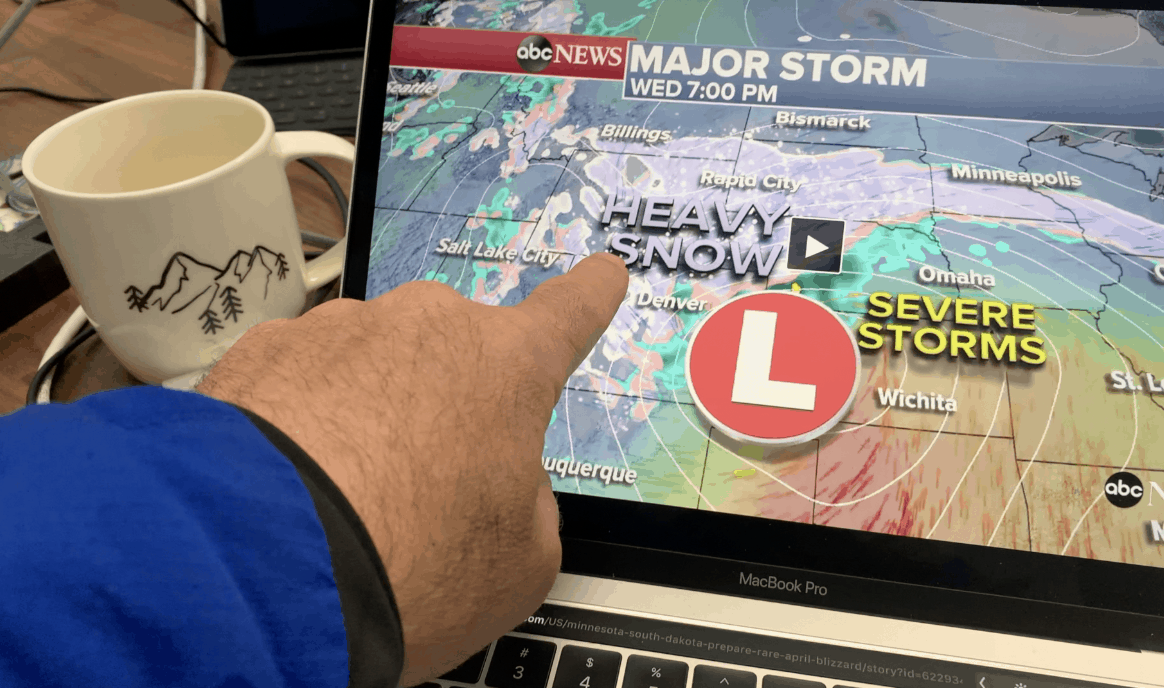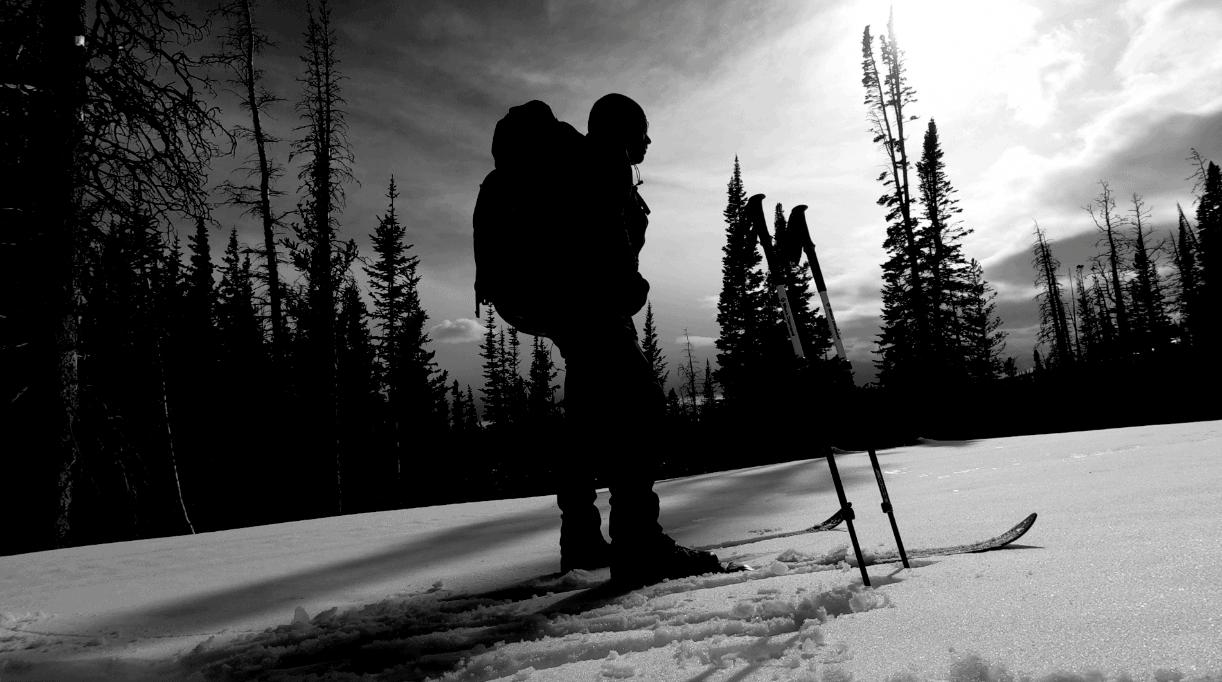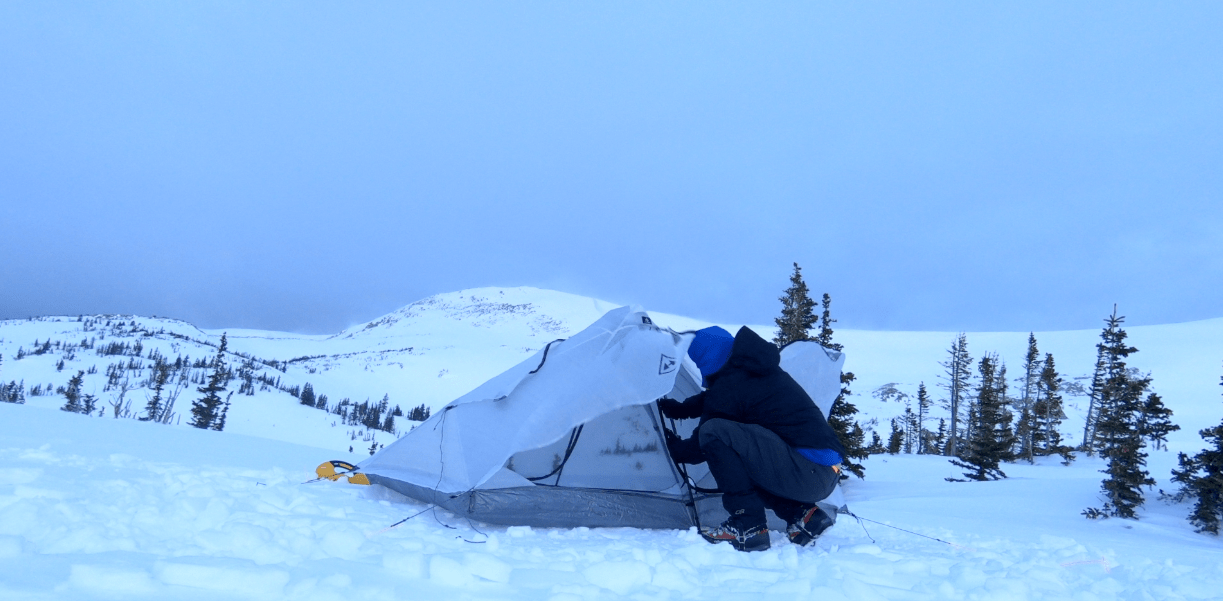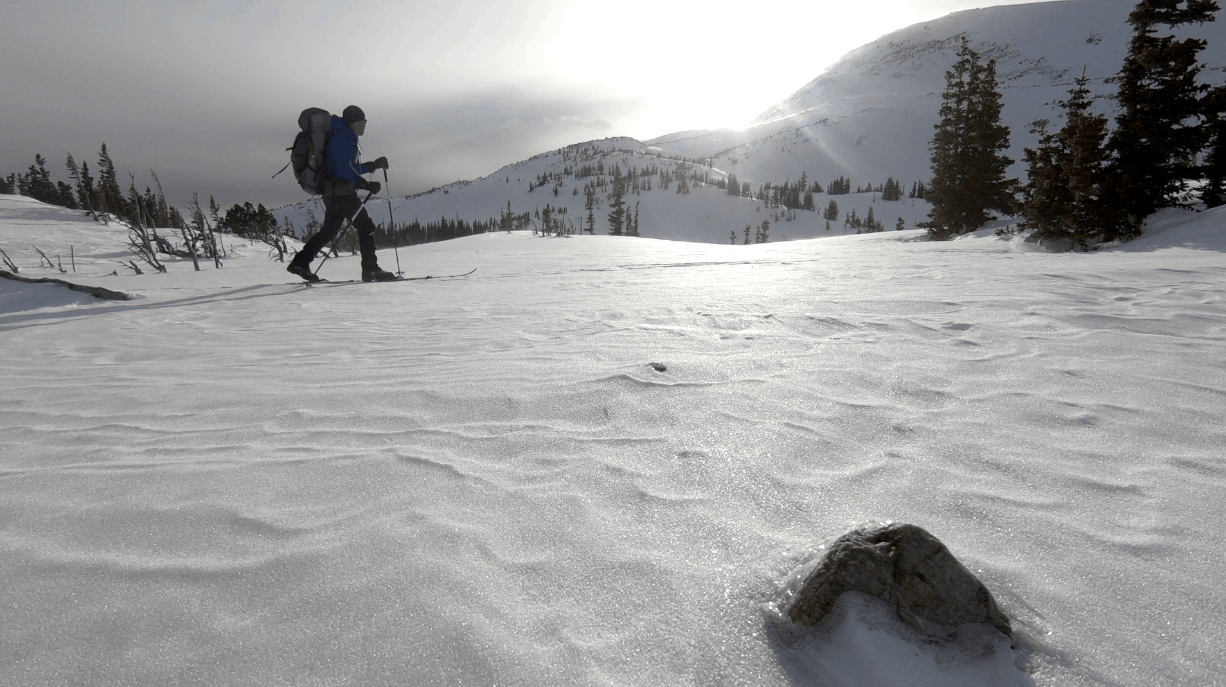Introduction
On the leading edge of the last bomb cyclone storm cycle that hit the Rockies and Midwest this spring (April 2019), I was hoping to get in a quick 24-hour trip up in the high country of Wyoming’s Snowy Range.

Apparently, the pressure bars compressed a little bit more than what was predicted, and I faced some breezy conditions that were a little more than what my ultralight shelter system could handle, so I retreated in the middle of the night.
Enjoy the video:

Summary Notes
Route:
- My route followed snowmobile trails across summer roads for a couple of hours, and then up into the untracked backcountry via spruce forest, subalpine fir, traversing high benches in cliffy terrain, and finally into a glacial cirque at 10,800 feet. I arrived in camp a little more than an hour before sunset.
- My route back down to the trailhead was a little different. Since I was navigating in a blizzard in the dark, I opted for a longer but safer route through less steep terrain, intersected a summer road bed, and then used a summer road network to weave my way back to my original approach route.
Weather:
- Temperatures ranged from about 23 F to 41 F during the trip, with wind chills near 0 F.
- Winds increased from 10-15 mph (gusting to 20+ mph) at the beginning of the trip to 40-50 mph (gusting to 65+ mph) by the time I decided to bail.
- Skies were partly cloudy, with periods of bright sunshine, on the hike in. During the night, I couldn’t see any stars, and the weather devolved into whiteout conditions. I assumed it was a result of a snowstorm, but after reviewing satellite image history upon my return, the night skies were actually totally clear. The source of the whiteout was 100% a result of windblown snow – a ground blizzard.

Instrumentation:
- I recorded weather data (temp, humidity, etc.) using two Kestrel Drop D3FW devices (one inside the tent, one outside – although from watching the video you’ll see that the conditions weren’t so different between the two!).
- I recorded wind speeds using a Kestrel 5500 mounted on a rotating weather vane that was affixed to the top of a 24 in (60 cm) tall sapling stump with an Ultrapod Mini.
- I was able to monitor weather data from all devices from inside the tent, using Kestrel apps and a Bluetooth connection to my smartphone.

Gear Notes:
- Shelter: I used the Hyperlite Mountain Gear Dirigo 2 tent on this trip. Admittedly, this isn’t the type of conditions the tent is designed for. In fact, these conditions would be problematic for any three-season shelter. However, I was able to gather some pretty good data and experience with the shelter that should add value to my forthcoming review of the Dirigo.
- Stakes: buried sticks as deadmen, cut using the Suluk 46 Uki Buck Saw (4.5 oz!).
- Guylines: stock HMG guylines attached to 1mm Dyneema cord. I experienced two failures of the cord in two separate wind gusts, which broke the cord. On another guyline, the thin Dyneema cord tore through a stock HMG guyline (the 1mm Dyneema was attached to the HMG guyline with a sheet bend with an extra bight).
- Sleeping pad: A Nemo Astro Lite (insulated) – large size. This is the comfiest mattress I own but it doesn’t have sufficient insulation for sleeping directly on snow at subfreezing temperatures. I should have added a thin foam pad. It’s not as warm as my NeoAir XTherm, but far more comfortable.
- Sleeping Quilt: I used the REI Magma Trail Quilt 30 and wore all of my clothes to bed. The quilt performed like a champ and kept me warm and dry enough, even with wind and spindrift blowing through my shelter.
- Buff: My merino Buff was a critical piece of equipment during the night. I wore it as a face tunnel to keep spindrift out while I was trying to sleep. I would have rather had something like the new Timmermade Waterbear Hood.
- Insulating Clothing (in addition to a thin wool hat, light gloves, ski gloves, ski socks, trekking pants and a merino hoody): lightweight long underwear bottoms, an active insulation hoody, and an Apex-insulated jacket.
- Shell Clothing: the most comfortable WPB jacket I’ve ever owned (I size up one size so I can layer it over my puffy jackets), and some ultralight WPB pants.
- Ski Gear: leather insulated Nordic BC NNN boots, nordic backcountry skis with a wax/waxless base and full metal edges, manual Nordic BC NNN bindings, and lightweight kicker skins.

Lessons Learned:
- I mostly felt pretty calm during the whole experience. I suppose I attribute that to having experienced these conditions before, having gear (except for the shelter system) that was matched to the conditions, and knowing that even if I retreated in the middle of the night in a storm, I could simply go slow, make decisions carefully, and I’d get out safely.
- I’m very appreciative for a high enough level of fitness that provides me with a lot of reserves to manage adversity when needed, without facing the anxiety that comes with being too fatigued or sore to have bailout options.
- Stormy conditions can manifest themselves at high elevations long before a weather reporter down in town starts to experience them.

Disclosure
- Affiliate links: Some (but not all) of the links in this review may be “affiliate” links, which means if you click on a link to one of our affiliate partners (usually a retailer site), and subsequently make a purchase with that retailer, we receive a small commission. This helps us fund our editorial projects, podcasts, instructional webinars, and more, and we appreciate it a lot! Thank you for supporting Backpacking Light!



Home › Forums › Field Notes: Retreat from a Spring Alpine Storm